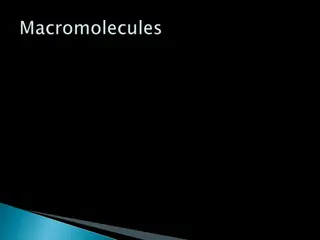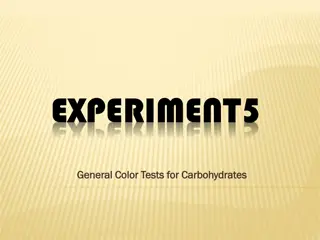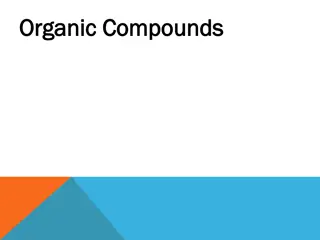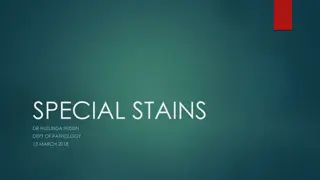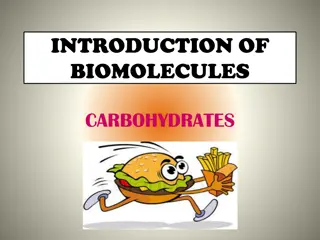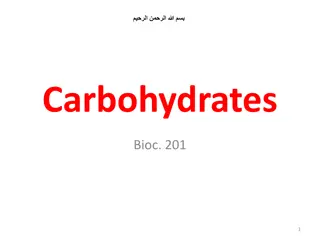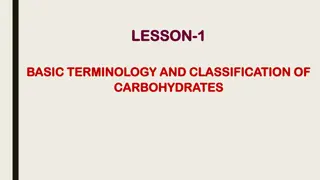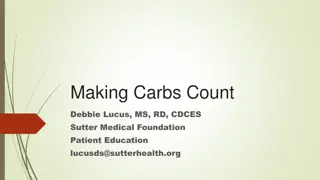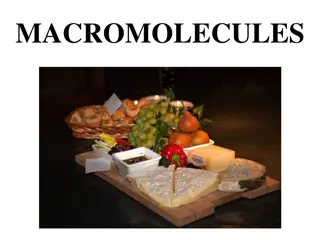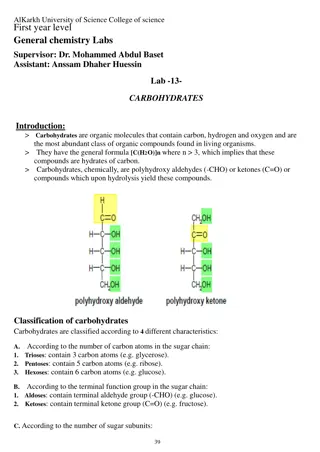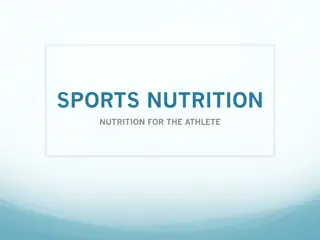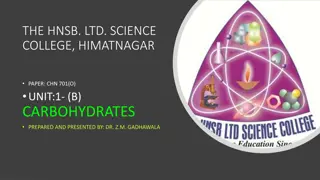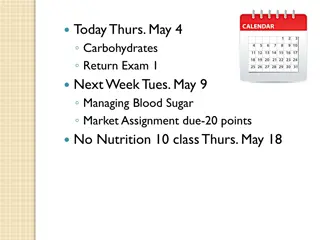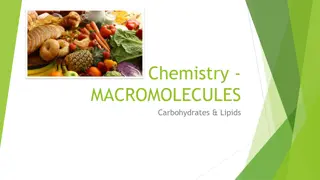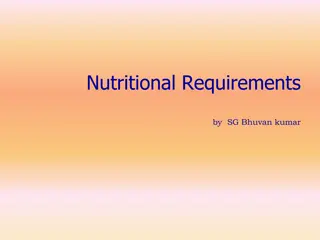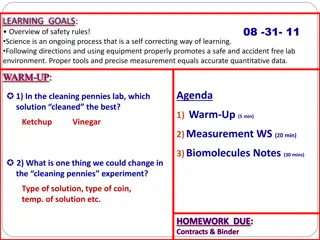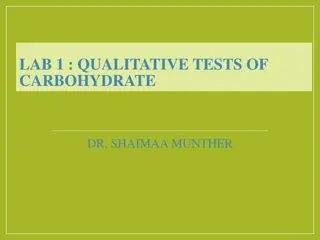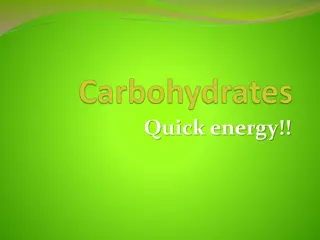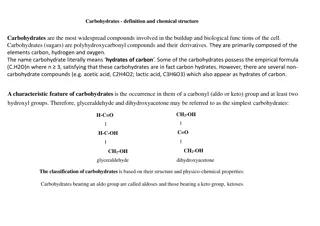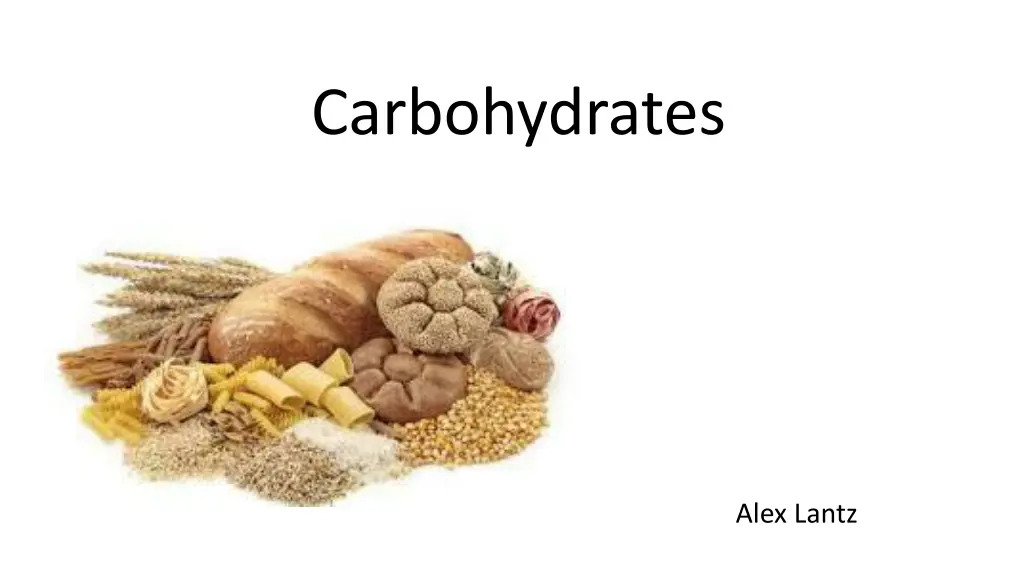
Understanding Carbohydrates: Importance and Types
Explore the world of carbohydrates with this comprehensive guide covering monosaccharides, disaccharides, and polysaccharides. Learn about the role of carbohydrates in food sources, their molecular structures, and their significance in digestion and energy production. Discover the different types of carbohydrates and their impact on human health.
Download Presentation

Please find below an Image/Link to download the presentation.
The content on the website is provided AS IS for your information and personal use only. It may not be sold, licensed, or shared on other websites without obtaining consent from the author. If you encounter any issues during the download, it is possible that the publisher has removed the file from their server.
You are allowed to download the files provided on this website for personal or commercial use, subject to the condition that they are used lawfully. All files are the property of their respective owners.
The content on the website is provided AS IS for your information and personal use only. It may not be sold, licensed, or shared on other websites without obtaining consent from the author.
E N D
Presentation Transcript
Carbohydrates Alex Lantz
Carb Loading? FACT OR FICTION Before Video Before Video Why? How? After Video After Video With What?
Lesson Objectives Students will be able to explain the difference between monosaccharides, disaccharides, and polysaccharides. Students will be able to illustrate the formation of a disaccharide molecule from two monosaccharides. Students will be able to explain how the human body processes carbohydrates for energy and what happens to the products that are not used.
Important Biological Macromolecules! Carbohydrates Lipids Nucleic Acids Proteins
What are Carbohydrates? Molecular Compounds made from 3 elements 1.) 2.) 3.) Have a general molecular formula: ( )n Carbohydrates are also known as , or sugars.
Role of Carbohydrates Why are they important to us? Major source of Contain assists in digestion and cholesterol management which Primarily found in food sources such as Bread products (grains) Fruits and Vegetables
Representation of a sugar molecule Cyclic Model Most Commonly used for diagrams Linear Model Able to see all bonds
General Types of Carbohydrates MONOsaccharides -composed of molecule sugar DIsaccharides -composed of molecules sugar POLYsaccharides -composed of many sugar molecules
Monosaccharides Single sugars Classified by the number of Carbon atoms in each molecule 3 Carbons = 5 carbons = 6 carbons = Examples of monosaccharides: 1.) 2.)
Disaccharides Formed from two monosaccharides Formed by a reaction Held together by a Ring shaped sugar molecule bonded to another molecule bond Examples: 1.) 2.)
Polysaccharides Formed from many sugar molecules bonded by dehydration reactions. Held together by glycosidic bonds Can be in two different forms: or Examples:
Glycosidic Bonds a closer look H H
Carbohydrates Energy How? Carbohydrates Enter the body reaction. and broken down into monosaccharides using a Monosaccharides converted to if not already in form Single molecules can now move throughout the body by Small Intestine Liver Blood Stream Concentration Gradient Taken up by cells Glucose used for energy, liver stores excess, beyond excess turned into
Where does the glucose go once in the bloodstream? The Carbohydrate Path What does the liver do? Food Small Intestine Monosaccharides Glucose Blood Stream Cells Storage
Carbohydrates Introduction Review Foods Monosaccharides, Disaccharides, Polysaccharides Bonds and Reactions Glycosidic bonds formed by dehydration reactions. Broken by hydrolosis. Energy Carbohydrates broken into monosaccharides, converted to glucose, and used or stored in the body. Representation Cyclic or linear

